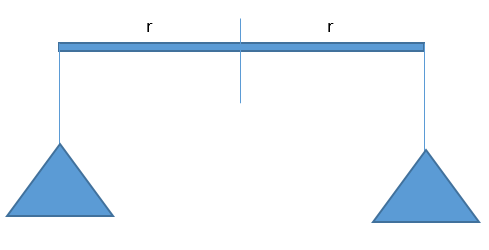
The pans of a physical balance are in equilibrium. Air is blown under the right hand pan, then the right hand pan will:
A. move up
B. move down
C. move erratically
D. remains at the same level
Answer
220.2k+ views
Hint: To keep the physical balance at equilibrium, the horizontal rod must be in horizontal position, i.e. net torque acting about the balancing point should be zero.
Complete step by step solution:

Image: The pans of a physical balance
When the pans of the physical balance is at equilibrium the net torque acting about the point of balance is zero. When the air is blown under the right hand pan then using Bernoulli’s theorem, the pressure above the right hand pan is greater than the pressure under the right hand pan. There is a pressure difference between the upper and lower part of the right hand pan.
Let the pressure difference is \[\Delta P\] and the area of the pan is A. Then the extra unbalancing force acting on the right hand pan is,
\[F = \left( {\Delta P} \right)A\]
Using the formula of torque, the distance between the balancing point and the point of application of force is r.
Then the torque applied due to extra unbalancing force about the balancing point is,
\[\tau = \left( {\Delta P} \right)Ar\]
The direction of the torque is clockwise, i.e. the right hand pan will move down and the left hand pan will move up. Hence, when air is blown under the right hand pan then the right hand pan move down.
Therefore, the correct option is B.
Note: To keep the body at equilibrium the net force acting on the body must be zero. Also, the net moment of the forces about any point on the body must be zero. At static condition the pressure difference due to air is negligible with respect to the width of the pan’s horizontal dimension, so the net force acting on both the pans in upward direction is balanced by the force acting downward.
Complete step by step solution:

Image: The pans of a physical balance
When the pans of the physical balance is at equilibrium the net torque acting about the point of balance is zero. When the air is blown under the right hand pan then using Bernoulli’s theorem, the pressure above the right hand pan is greater than the pressure under the right hand pan. There is a pressure difference between the upper and lower part of the right hand pan.
Let the pressure difference is \[\Delta P\] and the area of the pan is A. Then the extra unbalancing force acting on the right hand pan is,
\[F = \left( {\Delta P} \right)A\]
Using the formula of torque, the distance between the balancing point and the point of application of force is r.
Then the torque applied due to extra unbalancing force about the balancing point is,
\[\tau = \left( {\Delta P} \right)Ar\]
The direction of the torque is clockwise, i.e. the right hand pan will move down and the left hand pan will move up. Hence, when air is blown under the right hand pan then the right hand pan move down.
Therefore, the correct option is B.
Note: To keep the body at equilibrium the net force acting on the body must be zero. Also, the net moment of the forces about any point on the body must be zero. At static condition the pressure difference due to air is negligible with respect to the width of the pan’s horizontal dimension, so the net force acting on both the pans in upward direction is balanced by the force acting downward.
Recently Updated Pages
Electricity and Magnetism Explained: Key Concepts & Applications

JEE Energetics Important Concepts and Tips for Exam Preparation

JEE Isolation, Preparation and Properties of Non-metals Important Concepts and Tips for Exam Preparation

JEE Main 2021 July 25 Shift 1 Question Paper with Answer Key

JEE Main 2021 July 22 Shift 2 Question Paper with Answer Key

States of Matter Chapter For JEE Main Chemistry

Trending doubts
JEE Main 2026: Application Form Open, Exam Dates, Syllabus, Eligibility & Question Papers

Understanding Uniform Acceleration in Physics

Derivation of Equation of Trajectory Explained for Students

Hybridisation in Chemistry – Concept, Types & Applications

Understanding the Angle of Deviation in a Prism

How to Convert a Galvanometer into an Ammeter or Voltmeter

Other Pages
Thermodynamics Class 11 Physics Chapter 11 CBSE Notes - 2025-26

JEE Advanced Marks vs Ranks 2025: Understanding Category-wise Qualifying Marks and Previous Year Cut-offs

Units And Measurements Class 11 Physics Chapter 1 CBSE Notes - 2025-26

NCERT Solutions For Class 11 Physics Chapter 8 Mechanical Properties Of Solids

Motion in a Straight Line Class 11 Physics Chapter 2 CBSE Notes - 2025-26

NCERT Solutions for Class 11 Physics Chapter 7 Gravitation 2025-26




